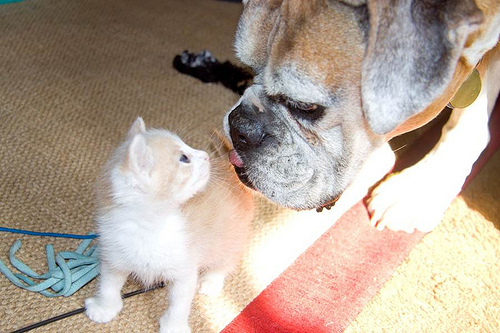Caring For Your Aging Dog – 8 Common Conditions You Should Know

Pete the senior boxer takes kitten socialization duties very seriously. (Image Copr. Tonya Jensen)
When November rolls around each year we take time to celebrate the many blessings we’ve enjoyed. Pet people of course give thanks for their animal companions, and November traditionally is Adopt A Senior Pet Month.
Do you love a senior citizen canine? Join the crowd! Fifty percent of owners share their heart with pets aged seven or older. Modern veterinary care helps many dogs stay healthy a decade or more, and Toy dogs sometimes double that and age gracefully well into their twenties. A longer life increases the odds dogs develop “old fogie” problems, though. That’s why I wrote the book Complete Care for Your Aging Dog because medical help is important–but the book also explains how you can keep your old-timer happy and healthy.
Heck, I am so much a believer in the fact that senior dogs can still have fun and remain engaged in life, that Bruno (a senior citizen tracking dog) plays a featured role in my thriller LOST AND FOUND. Here’s a quick sample of some of the simple and/or inexpensive tips for dealing with these 8 common aging dog issues.
Arthritis can affect all dogs but large breeds are most prone. Extra weight puts greater stress on the joints. Achy joints cause limping, difficulty climbing stairs or getting up after naps. A heating pad placed under the dog’s bed soothes creaky joints. Gentle massage as well as OTC supplements such as omega-3 fatty acids and glucosamine-type products also helps. Low impact exercise—walks or swimming—and slimming down pudgy pooches delays problems. Provide steps—even a cardboard box—to help old dogs navigate stairs or hop onto the sofa.
Dogs suffer from cataracts more than any other species, but blindness rarely slows them down. They compensate by relying more on sense of smell and hearing. Owners may not notice vision loss unless the dog visits unfamiliar surroundings. Avoid rearranging furniture so blind dogs can rely on their memory of familiar landmarks. Baby gates placed near stairs protect blind dogs from falling. Avoid startling blind dogs by announcing your presence before walking near or petting. Blind dogs enjoy games with noisy toys they can hear, or hide-and-seek with strong scented objects.
Constipation affects many old dogs. When they stop moving on the outside, the inside movement slows down, too. A treat of a half cup milk, or 1 to 3 teaspoons of nonflavored Metamucil twice a day (depending on size of the dog), or high fiber foods like raw carrot or canned pumpkin help keep things moving. Most dogs like the taste of pumpkin or squash.
Is he ignoring your commands? Sleeping too much? He could be deaf. Hearing naturally fades with age, but you can compensate by using vibration and hand signals. Stomp your foot to get his attention. Then use a flashlight switched on/off to call him inside, or the porch light to signal dinner is served. Vibrating collars also work well to communicate with deaf dogs.
Eighty percent of dogs have dental problems by age three, and the risk increases 20 percent for each year of the dog’s life. Enzymes in special “dental diets” and meat-flavored pet tooth paste helps break down plaque. Offer dental chews, rawhides, a chew-rope covered with dog toothpaste, or even apples and carrots for healthy tooth-cleaning chews.
Does she leave a wet spot where she sleeps? Incontinence refers to loss of bladder tone, and it mostly affects old lady spayed dogs. Prescription drugs may help, but management is equally important. Increase her potty breaks, and pick up water bowls two hours before bedtime. Toddler “pull up” pants work for some dogs or choose doggy diapers to help contain the urine.
Forty to 50 percent of dogs aged five to twelve are overweight. Obesity often affects aging dogs because they exercise less but eat the same amount. Extra weight makes arthritis worse. Feed smaller meals inside puzzle toys so that the dog takes longer to eat and feels more satisfied as she works to earn her kibble.
Thirty percent of dogs aged 11 to 12 show one or more signs of senility—canine Alzheimer’s. Affected dogs act confused, forget to ask to go outside, cry, and may not recognize you. This heartbreaking condition often causes owners to put dogs to sleep when symptoms develop. A prescription of Anipryl from your vet temporarily reverses signs in about 30-60 percent of dogs, but the supplement Cholodin also works pretty well. Two commercial foods (Hill’s Prescription b/d, and Purina Pro Plan Senior 7+ Original) also reverse signs for a while in some dogs. The saying “use it or lose it” also applies to dogs, so delay the onset of senility by exercising the doggy brain with obedience drills, interactive play, and puzzles.
What are some other “home care” tips that have worked well for YOUR “golden oldie” dog? Have you discovered some awesome care product that makes life easier for you, and more comfy for your pet? What are the “old dog” issues that you deal with? Please share!
I love hearing from you, so please share comments and questions. Do you have an ASK AMY question you’d like answered? Do you have a new kitten and need answers? Stay up to date on all the latest just subscribe the blog, “like” me on Facebook, listen to the weekly radio show, check out weekly FREE PUPPY CARE newsletter, and sign up for Pet Peeves newsletter. Stay up to date with the latest book give aways and appearances related to my THRILLERS WITH BITE!
Filed under: Dog Training & Care Tagged: adopt a senior pet month, Amy Shojai, caring for your aging dog, common old dog health problems, Complete Care for Your Aging Dog, Lost And Found, old dog and kitten, old dogs, Tonya Jensen, www.amyshojai.com





